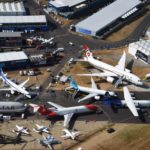Airlines are no strangers to sudden financial impact circumstances, 9/11, SARS, Ebola have all made their mark on the aviation industry, but as coronavirus – more specifically new COVID19 – spreads across the globe, the airline industry could be positioned as the first domino to fall with aerospace manufacturing and services and the global economy as a whole being knocked down soon after.
At the time of writing, close to 2,500 people have died – the vast majority in China. There have been almost 80,000 infected and so far 25,000 of those have been given the all-clear.
The figures are alarming. But at a recent aviation legal conference in Dubai it was pointed out that in the United States last year an estimated 35.5 million people contracted influenza, 16.5 million people went to a health care provider for their illness, there were 490,600 hospitalisations, and 34,200 deaths from influenza.
Indeed, while the news headlines continue to lead on the drama of the infection, so far this year in the United States alone, some 6,600 people have died and 120,000 people have been hospitalised with the flu. A far higher percentage rate of threat from flu to health than from coronavirus.
At the legal event questions were asked about airlines providing face masks – answer: only to stop passengers putting their hands in their mouths.
From positive to negative
But facts do not ease fears. And airlines are suffering.
Just two months after publishing positive forecasts for the industry, IATA is now suggesting there could be almost a 5 per cent drop in profitability. “This will be a very tough year for airlines,” Alexandre de Juniac, IATA’s director general, said. “Airlines are making difficult decisions to cut capacity and in some cases routes.”
ICAO reported about 70 airlines — including American Airlines and the Lufthansa group — have cancelled all international flights to and from mainland China, while 50 carriers, such as Singapore Airlines and Cathay Pacific, have reduced capacity.
Other airlines have not. Ethiopian Airlines faced outrage from other African carriers and from its own nationals for continuing to fly to China – where COVID19 was first reported. The airline serves five destinations in China with 35 flights a week and has 40 per cent of the market between China and Africa.
But the leading African airline has defended its position, arguing that a travel ban is not an internationally recommended precautionary measure to curb the spread of coronavirus and that the WHO has advised that there is no need to impose travel ban to/from China due to the outbreak, they said.
Passengers arriving in Addis Ababa pass through a series of checks before entering the country. FINN will be talking to the airline and others from the industry next week from Addis Ababa as we cover the Aviation Africa Summit.
China itself has been critical of travel restrictions imposed around country of origin. Responding to the USA’s warnings for its citizens to avoid China, the foreign affairs ministry said: “Just as the WHO recommended against travel restrictions, the US rushed to go in the opposite way. Certainly not a gesture of goodwill.”
Asia-Pacific feels the impact
The biggest impact on the airline industry will be in the Asia-Pacific market.
According to IATA, there is a potential 13 per cent full-year loss of passenger demand for carriers in the Asia-Pacific region. Considering that growth for the region’s airlines was forecast to be 4.8 per cent, the net impact will be an 8.2 per cent full-year contraction compared to 2019 demand levels. In this scenario, that would translate into a $27.8 billion revenue loss in 2020 for carriers in the Asia-Pacific region—the bulk of which would be borne by carriers registered in China, with $12.8 billion lost in the China domestic market alone.
“We estimate that global traffic will be reduced by 4.7 per cent by the virus, which could more than offset the growth we previously forecast and cause the first overall decline in demand since the Global Financial Crisis of 2008-09. And that scenario would translate into lost passenger revenues of $29.3 billion.
IATA said was also important for governments to take leadership in shoring up their economies.
Governments need to step in for continued connectivity
The Singapore government, for example, is allocating funds to provide financial relief to airlines struggling to economically maintain connectivity. The S$112 million ($80.5 million) package will comprise rebates on aircraft landing and parking charges, assistance to ground handling agents, and rental rebates for shops and cargo agents at Changi Airport, says Singapore’s finance minister Heng Swee Keat while announcing the country’s budget plan for fiscal 2020, which begins on 1 April.
Airlines that had operated scheduled passenger flights between China and Singapore before the coronavirus outbreak will receive landing credits, Heng says, while those that continue to operate flights to China amid the ongoing outbreak will receive rebates on their landing charges.
A full rebate on parking charges is being extended to all scheduled passenger flights to Singapore. In addition, a 10 per cent landing charge rebate will also be given to all freighter carriers into Singapore, and applied to all scheduled passenger flights from Southeast Asia to Singapore.
“Airlines and governments are in this together. We have a public health emergency, and we must try everything to keep it from becoming an economic crisis. Relief on airport costs will help maintain vital air connectivity. Other governments should take good note and act quickly,” said de Juniac.
Learning from SARS
History has shown us that the industry does bounce back.
SARS was estimated to have impacted the travel industry for up to half a year, and that appears to be a reference point for airlines and the broader aviation industry as it begins its planning for the rest of the year.
But the effect of the Coronavirus could have a greater impact
China’s economy was running at just 40 per cent to 50 per cent capacity during February, according to a Bloomberg Economics report, after efforts to contain the spread closed stores, brought factories to a halt and triggered a virtual shutdown of the domestic airline industry. Employers have encouraged people to stay home, shopping malls and restaurants are empty, and amusement parks and theatres are closed.
Outbreak will impact China’s role in global manufacturing
China’s increasingly important role on the supply chain – not just for aerospace but for global manufacturing as a whole – has been growing. The virus has disrupted supply chains of the world’s largest carmakers and hit sales at companies from Apple where the manufacture of the iPhone is threatened, to fashion houses Burberry and Nike.
A new Dun & Bradstreet study estimates that 163 of the Fortune 1000 have tier 1 suppliers—those they do direct business with—in the area. And 938 have tier 2 suppliers, which feed the first tier.
The concern over travel is also seeing an impact for the tourism industry. China’s outbound tourist numbers has been growing exponentially. But others are halting travel even though the reasons have been factually irrational.
This month’s Singapore Air Show which earned the city-state some $250m in 2018, will have seen a dramatic drop owing to cancellations by 70 companies including defence giant Lockheed Martin. The Mobile World Congress, a giant telecoms conference due to take place in Barcelona was cancelled after companies from Vodafone and BT to Facebook and Amazon pulled out.
I am proud to say that I am not bowing to hysteria. I will be flying to Dubai, Addis Ababa, Beirut and Abu Dhabi over the next few weeks for major aerospace events like Aviation Africa and the Global Aerospace Summit. I will wash my hands regularly and do my bit to get us back on track in good time.

